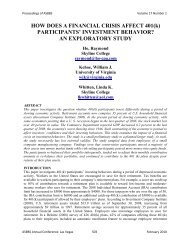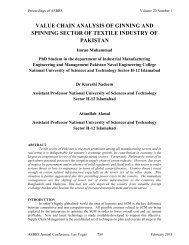stock repurchase announcements: a test of market ... - Asbbs.org
stock repurchase announcements: a test of market ... - Asbbs.org
stock repurchase announcements: a test of market ... - Asbbs.org
Create successful ePaper yourself
Turn your PDF publications into a flip-book with our unique Google optimized e-Paper software.
Allied Signal, Dupont, Honeywell, Boeing and Intel (Mondy et. al, 02) Thus, as<br />
demonstrated by these companies, the feedback tool is appropriate across various<br />
industries. The 360-degree feedback tool is a multi-rater evaluation that involves<br />
feedback from various levels in the <strong>org</strong>anization, including one's managers, peers and<br />
direct reports. The type <strong>of</strong> information targeted in the feedback questionnaire should be<br />
limited to knowledge, skills and behaviors, while avoiding personality traits or styles<br />
(360” FAO, 02) Knowledge refers to an individual's level <strong>of</strong> familiarity with the job,<br />
industry and company, while skills refer to the individual's level <strong>of</strong> pr<strong>of</strong>iciency <strong>of</strong> the<br />
required tasks. Behaviors are patterns in relating to the environment, such as energy,<br />
optimism and trustworthiness. When preparing the information to include in the feedback<br />
tool, the <strong>org</strong>anization must outline the criteria relevant to the job being performed and<br />
exercise caution to avoid including irrelevant information that could hinder the process. It<br />
is imperative to remember that this feedback system is not intended to rate individual<br />
personalities; rather, it is designed to help the individual identify areas <strong>of</strong> strength and<br />
areas needing development, which are related to job performance. While normally there<br />
seems to be two different angles <strong>of</strong> the tool's purpose: decision-making and development<br />
(Zomorrodian 03), it seems that this powerful feedback method can play an strategic role<br />
for <strong>org</strong>anization if it is integrated to a kind <strong>of</strong> system-wide holistic performance<br />
management system that goes well beyond the individual appraisal and covers units and<br />
the total system levels.<br />
Balanced Score Card (BSC) is another strategic oriented model that directly affects HR<br />
in the area <strong>of</strong> performance management. This model ties <strong>org</strong>anizational achievements in<br />
terms <strong>of</strong> customer satisfaction, financial goals, effectiveness <strong>of</strong> internal process, and<br />
learning and growth all together within the scope <strong>of</strong> the firm’s strategy. Balanced Score<br />
Card Institute considers the method a valuable and effective measurement-based<br />
management that builds on some key concepts <strong>of</strong> previous management ideas such as<br />
Total Quality Management (TQM), including customer-defined quality, continuous<br />
improvement, employee empowerment, and -- primarily -- measurement-based<br />
management and feedback (BSCI, 07)The model consists <strong>of</strong> three major characteristics as<br />
follows:<br />
1. Double-Loop Feedback: In traditional industrial activity, "quality control" and "zero<br />
defects" were the watchwords. In order to shield the customer from receiving poor<br />
quality products, aggressive efforts were focused on inspection and <strong>test</strong>ing at the end <strong>of</strong><br />
the production line. The problem with this approach is that the true causes <strong>of</strong> defects<br />
could never be identified, and there would always be inefficiencies due to the rejection <strong>of</strong><br />
defects. What Deming saw was that variation is created at every step in a production<br />
process, and the causes <strong>of</strong> variation need to be identified and fixed…. To establish such a<br />
process, Deming emphasized that all business processes should be part <strong>of</strong> a system with<br />
feedback loops. The feedback data should be examined by managers to determine the<br />
causes <strong>of</strong> variation, what are the processes with significant problems, and then they can<br />
focus attention on fixing that subset <strong>of</strong> processes. The balanced scorecard incorporates<br />
feedback around internal business process outputs, as in TQM, but also adds a feedback<br />
loop around the outcomes <strong>of</strong> business strategies. This creates a "double-loop feedback"<br />
process in the balanced scorecard.<br />
2. Outcome Metrics: You can't improve what you can't measure. So metrics must be<br />
developed based on the priorities <strong>of</strong> the strategic plan, which provides the key business<br />
drivers and criteria for metrics that managers most desire to watch. Processes are then<br />
Innovative HRM<br />
ASBBS E-Journal, Volume 4, No.1, 2008 207

















